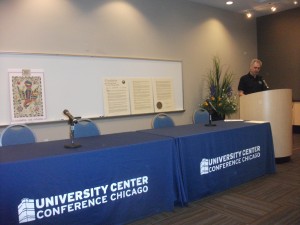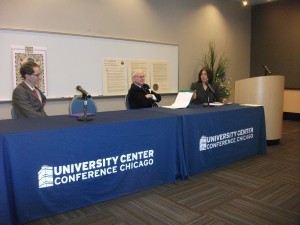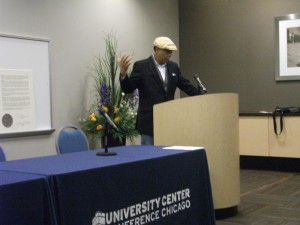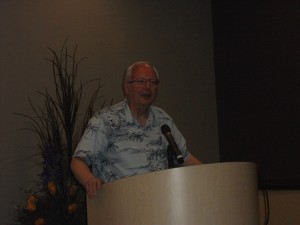Chicago, a city that has spawned at least its fair share of writers and attracted many more, has spawned a national museum dedicated to people who propagate the written word. The American Writers Museum (AWM) opened May 16 at 180 N. Michigan Avenue, situated amid a dense ecosystem of museums, parks, and other cultural attractions that make living in Chicago such a stimulating experience. Let me just state the basic premise up front: If you live in Chicago, or you are visiting, and you care about or have any curiosity about literature, this is worth a visit. It is not a huge museum, at least not now, and you need not worry that it will take all day. You can spend all day, but you can get a great deal out of it in two or three hours if you wish.
Literature, in the context of AWM, does not only mean fiction or poetry. One point that was immediately obvious to me during a visit last week was that the museum takes a broad view of both “writers” and what constitutes “writing.” Communication comes in many forms, and the museum seeks to explore how those forms change in response to numerous changing conditions in American society. AWM President Carey Cranston reinforced that point with me during a brief walk-through when I arrived, before turning me loose to make my own assessments of the exhibits. Thus, in the various displays one can encounter Charles M. Schulz, the author of the “Peanuts” comic strip, which made points about life, love, and laughter just as surely as Jane Jacobs, discussing the status of urban planning in the 1960s in The Death and Life of Great American Cities and Jean Toomer in Cane, an intriguing mix of fiction techniques that shed life on African-American life in the early 20th century. Creativity is not bounded by genre. It helps define genre.
Hold that thought for a minute while I explore with you the big question that drove me to visit in the first place. It is obvious enough how some other museums dedicated to natural history (Field Museum, e.g.) or technology and science (Chicago Museum of Science and Industry, or the Smithsonian Air and Space Museum in Washington, D.C.) make their subject visual and sometimes even tactile with displays of dinosaur skeletons or space capsules, accompanied by videos that help patrons relive the experience of exploring the moon. How does one take the words of poems, novels, memoirs, and other types of written expression and make them come alive in an institutional setting? After all, any library can create a display of the ten best novelists by simply stacking the books along a display counter to draw attention. As readers, we engage with these works by buying or borrowing the books and, well, reading them. So, what makes an American Writers Museum a vivid encounter with its subject matter?
 One answer lies in the timeline that greets you just to the right of the front desk after you enter. Running from 1490 to the present, it is not, as Cranston noted to me, a display of the best writers America has ever seen, but instead provides an emblematic display that allows you to see the relationship of major themes in American history to the writing American authors have produced. The United States of America, an independent nation for only half of that time and a maze of Spanish, French, Dutch, Russian, and British colonies as well as native societies at various times before and since, is rich in historical themes that have inspired literary responses. The vastness of a continent new to Europeans . . . . the interaction of cultures . . . . Civil War and its aftermath . . . . the struggle for civil rights . . . . the fight for dignity and identity for American Indians . . . . immigration and the assimilation of new peoples and cultures . . . . industrialization and its impact on a formerly agrarian nation . . . . America’s emergence on the world stage. One could go on, and one could navigate the endless subthemes and nuances of each topic, which is precisely what American writers, whatever their origins and perspectives, have done for more than five centuries.
One answer lies in the timeline that greets you just to the right of the front desk after you enter. Running from 1490 to the present, it is not, as Cranston noted to me, a display of the best writers America has ever seen, but instead provides an emblematic display that allows you to see the relationship of major themes in American history to the writing American authors have produced. The United States of America, an independent nation for only half of that time and a maze of Spanish, French, Dutch, Russian, and British colonies as well as native societies at various times before and since, is rich in historical themes that have inspired literary responses. The vastness of a continent new to Europeans . . . . the interaction of cultures . . . . Civil War and its aftermath . . . . the struggle for civil rights . . . . the fight for dignity and identity for American Indians . . . . immigration and the assimilation of new peoples and cultures . . . . industrialization and its impact on a formerly agrarian nation . . . . America’s emergence on the world stage. One could go on, and one could navigate the endless subthemes and nuances of each topic, which is precisely what American writers, whatever their origins and perspectives, have done for more than five centuries.
 Opposite the timeline, and complementing it, is a wall with the names of prominent writers on small boards built in that one can turn for additional information. Many, though not all, feature short videos one can launch with a finger touch that illustrate important points. I played with one for Ray Bradbury, one of my own favorites dating back to high school. The video quotes part of Fahrenheit 451 while showing a pile of books being consumed by fire. Alongside Bradbury’s name is a theme, in his case, Dystopian Literature; this occurs with each writer to help show the range of genre that American literature has produced, how it has responded to both contemporary and larger issues, seeking to excite the visitor’s imagination. Whether intentional or not, it excited mine simply by introducing me to writers previously unfamiliar to me, which is saying a lot. There are American writers of whose work any of us may know little or nothing but who have the potential to stir our thoughts and prod our consciences. That has always been the mission of good writing.
Opposite the timeline, and complementing it, is a wall with the names of prominent writers on small boards built in that one can turn for additional information. Many, though not all, feature short videos one can launch with a finger touch that illustrate important points. I played with one for Ray Bradbury, one of my own favorites dating back to high school. The video quotes part of Fahrenheit 451 while showing a pile of books being consumed by fire. Alongside Bradbury’s name is a theme, in his case, Dystopian Literature; this occurs with each writer to help show the range of genre that American literature has produced, how it has responded to both contemporary and larger issues, seeking to excite the visitor’s imagination. Whether intentional or not, it excited mine simply by introducing me to writers previously unfamiliar to me, which is saying a lot. There are American writers of whose work any of us may know little or nothing but who have the potential to stir our thoughts and prod our consciences. That has always been the mission of good writing.
 Near all that is a current, periodically changing exhibit, the Meijer Exhibit Gallery, which demonstrates some of the most potent creativity the museum has on display. Its first exhibit displays the work of poet W.S. Merwin, about whom I confess I knew nothing, but who is now a source of fascination for me. The small room one enters for “Palm: All Awake in the Darkness,” features a haunting 12-minute video with no human presence except for the soft voice-over of narrators reading from Merwin’s work dealing with the complex and problematic relationship of humanity and nature. The video features the view from inside a cabin in the Maui rainforest, redolent with the sounds of birds and insects and the abundance of life beneath the forest canopy. You may stand or sit on a simple bench and contemplate this immersive adventure into the mind of a poet. Merwin, now 89, has produced more than 50 volumes of poetry, according to the brochure that complements the exhibit, which discusses writer Gregory Bateson’s concept of an “ecology of ideas,” the network of impressions and perspectives that form our conscious and subconscious minds. Since the late 1970s, Merwin has lived in Hawaii on an old pineapple plantation he has restored to its natural state.
Near all that is a current, periodically changing exhibit, the Meijer Exhibit Gallery, which demonstrates some of the most potent creativity the museum has on display. Its first exhibit displays the work of poet W.S. Merwin, about whom I confess I knew nothing, but who is now a source of fascination for me. The small room one enters for “Palm: All Awake in the Darkness,” features a haunting 12-minute video with no human presence except for the soft voice-over of narrators reading from Merwin’s work dealing with the complex and problematic relationship of humanity and nature. The video features the view from inside a cabin in the Maui rainforest, redolent with the sounds of birds and insects and the abundance of life beneath the forest canopy. You may stand or sit on a simple bench and contemplate this immersive adventure into the mind of a poet. Merwin, now 89, has produced more than 50 volumes of poetry, according to the brochure that complements the exhibit, which discusses writer Gregory Bateson’s concept of an “ecology of ideas,” the network of impressions and perspectives that form our conscious and subconscious minds. Since the late 1970s, Merwin has lived in Hawaii on an old pineapple plantation he has restored to its natural state.
As a Lutheran, I found one other thing haunting. Merwin is a practicing Buddhist, and the brochure contains a typewritten, hand-edited draft of a poem called “Place.” It begins:
On the last day of the world
I would want to plant a tree
Curiously, for years, I have known that Martin Luther is reputed to have said, “If I knew the world would end tomorrow, I would plant a tree.” The 500th anniversary of the Reformation is upon us, and I know these two men came from very different places to express the same thought. But if a 16th-century religious reformer and a 20tt-century Buddhist poet can reach the same conclusion about the resilience of our commitment to the earth and the stubbornness of faith, perhaps there is hope for us all, after all.
 AWM will be sponsoring events in a modest meeting room that features another challenging exhibit, “The Mind of a Writer,” which explores the connections between writer and audience. Professional writers clearly cannot earn a living without an audience, and the practical questions are both how to define and shape that audience and how to reach that audience. The “reach” forces us to explore the role of technology and institutions in facilitating those connections, which clearly have evolved over time. Displays make us think about the evolution of the book shop, starting with the Moravian Book Shop, launched in Bethlehem, Pennsylvania, in 1745, largely to import religious publications, but continuing into such modern innovations as Oprah’s Book Club, using the medium of television to connect viewers with writers; bookstore chains such as the now defunct Borders; and Amazon, allowing people to order books through the Internet. Of course, writers have also used periodicals, which in their heyday relied very much on the efficiency of the U.S. Postal Service, as well as other media. Playwrights do not expect people to read their writing, but to hear it on stage. Screenwriters reach people through televised performances of their scripts, and so on. All of that got me wondering whether AWM missed a beat by not discussing the Internet not only as a mechanism for selling printed works but as a medium in itself for digital publishing. After all, the very premise of my visit was to review the museum not in print but online, by blogging. Maybe I missed it, but where was the discussion of blogging as one of the most modern innovations in audience creation? Anyone out there? Judging from the list of subscribers on my admin site, it would seem there are thousands. In the aggregate, probably hundreds of millions. It’s a brave new world. But I suspect it may not be long before AWM addresses this phenomenon.
AWM will be sponsoring events in a modest meeting room that features another challenging exhibit, “The Mind of a Writer,” which explores the connections between writer and audience. Professional writers clearly cannot earn a living without an audience, and the practical questions are both how to define and shape that audience and how to reach that audience. The “reach” forces us to explore the role of technology and institutions in facilitating those connections, which clearly have evolved over time. Displays make us think about the evolution of the book shop, starting with the Moravian Book Shop, launched in Bethlehem, Pennsylvania, in 1745, largely to import religious publications, but continuing into such modern innovations as Oprah’s Book Club, using the medium of television to connect viewers with writers; bookstore chains such as the now defunct Borders; and Amazon, allowing people to order books through the Internet. Of course, writers have also used periodicals, which in their heyday relied very much on the efficiency of the U.S. Postal Service, as well as other media. Playwrights do not expect people to read their writing, but to hear it on stage. Screenwriters reach people through televised performances of their scripts, and so on. All of that got me wondering whether AWM missed a beat by not discussing the Internet not only as a mechanism for selling printed works but as a medium in itself for digital publishing. After all, the very premise of my visit was to review the museum not in print but online, by blogging. Maybe I missed it, but where was the discussion of blogging as one of the most modern innovations in audience creation? Anyone out there? Judging from the list of subscribers on my admin site, it would seem there are thousands. In the aggregate, probably hundreds of millions. It’s a brave new world. But I suspect it may not be long before AWM addresses this phenomenon.
Just beyond this area is a section where you can sit at an old-fashioned typewriter and play. The staff each day places sheets of paper in a tray with the opening lines or fragments of famous quotes. Your job: start pecking away to fill in the blanks with your own thoughts about how the quote should end. For writers like me who are almost preternaturally oriented to the computer screen, it is slightly disconcerting to hit keys that sometimes skip, but the experience is indisputably tactile, though arguably less so than perhaps using a quill pen. In any event, there is a wall with clips. You are invited to hang up your work when you are done. I did not get around to asking what the staff does with these at the end of each day. Maybe you should ask when you visit.
 I hope you are more dexterously agile than I appear to be with one other exhibit that allows you to move any of a number of drifting images across a screen for a surprise exploration of an individual writer’s work. One of several lines of inquiry allows you to hear a short oral reading, but I had trouble triggering that feature because my index finger seemed not to hit the precise part of that line that activated the recording, at least not on the first try. I found myself a little frustrated, but a generation that has become adept at using its thumbs to tap out smartphone messages may be more adept in this respect. I was never very skilled with video games, either. We all have our limitations.
I hope you are more dexterously agile than I appear to be with one other exhibit that allows you to move any of a number of drifting images across a screen for a surprise exploration of an individual writer’s work. One of several lines of inquiry allows you to hear a short oral reading, but I had trouble triggering that feature because my index finger seemed not to hit the precise part of that line that activated the recording, at least not on the first try. I found myself a little frustrated, but a generation that has become adept at using its thumbs to tap out smartphone messages may be more adept in this respect. I was never very skilled with video games, either. We all have our limitations.
There are other features, including one on Jack Kerouac that includes the “scroll manuscript” he pasted together for On the Road, and a room on Chicago writers, since the museum lives here. I am sure there will be more in the future. The museum leaders appear to have built out their infrastructure of sponsors and board members, and if you’d like to know more, you can visit the website. That is not my mission here. As an active American writer, I hope I’m offering you reasons to visit the museum itself.
Jim Schwab





